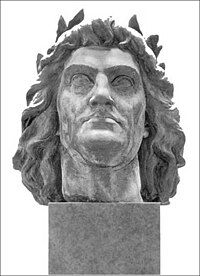King Matjaž


King Matjaž/Mátyás (Slovene: Kralj Matjaž, Hungarian: Mátyás király, Croatian: Kralj Matijaš) is a legendary king in Slovenia, Hungary, Croatia and in some other countries, based on pre-Christian traditions of Carantania[1] and in course of centuries gradually linked to a real life king, Matthias Corvinus of Hungary, who lived in the second half of the 15th century.[2] He has also been linked to the leader of the peasant's army that fought against the Turks in the Battle of Kokovo in July 1478.[3] A number of folk poems and stories about King Matjaž are known, the earliest ones originating in the western Slovene area of Tolmin from the 16th century.[4] He is mainly represented as the king who is just and a defender of his people, and the bringer of the golden age of prosperity.[1] It has been assumed that the legend was the basis for the name of the 1573 peasants' revolt leader Matija Gubec, actually named Ambroz Gubec.[5][6]
Content of the poems and stories
The folk poems tell about King Matjaž's fights with the Turks, about the kidnapping of his wife Alenčica, or his rescue from the Turkish jail. The stories about King Matjaž are arrangements of the poems or may have a different content. In this case, they tell about the King's rebellion against God and about his army, buried under a mountain.[4]
Traditions and memorials
The traditions related to the King Matjaž have a significant role in the Slovenian Carinthia, particularly the Mežica Valley, where a competition in building snow castles as well as visual art and literary writing related to King Matjaž takes place every January since 1993. This is related to a story, according to which King Matjaž sleeps in the Peca Mountain above the valley.[4] In the vicinity of the Peca hut,[4] there is a bronze sculpture of King Matjaž in the beginning of an abandoned pit.[7] It was designed by the sculptor and mountaineer Marjan Keršič in 1958,[8] put to bronze by the sculptor France Rotar, and placed in the cave in 1962.[9]
In the mid-1990s, King Matjaž has been depicted on the King of Diamonds card of the Slovene Tarock.[10] The depiction was based on a study led by the ethnologist Janez Bogataj, and the card was drawn by the academy-trained painter and illustrator Matjaž Schmidt.[11]
In the year 2006 Slovenian country musician Milan Pečovnik - Pidži spotted the image of King Matjaž carved into the rocks of mount Peca.[12][13]
References
- ^ a b Čeferin, Aleksandra (28 April 2008). "King Matjaž". Thezaurus.com: Slovenian Language and Cultural Resources. Institute for Slovenian Studies of Victoria. Retrieved 12 March 2012.
- ^ Šmitek, Zmago. "Kralj Matjaž: mavrični sij ljudskega junaka" (PDF). Acta Histriae (in Slovenian, Italian, and English). 17 (1–2): 132.
{{cite journal}}: Unknown parameter|trans_title=ignored (|trans-title=suggested) (help) - ^ Kralj, Drago (1 July 2009). "Nesrečni kralj Matjaž". Gore-ljudje (in Slovenian).
{{cite web}}: Unknown parameter|trans_title=ignored (|trans-title=suggested) (help) - ^ a b c d Kropej, Monika (2010). "Gradovi kralja Matjaža" (PDF). Živa kulturna dediščina Slovenije [Live Cultural Heritage of Slovenia] (in Slovenian). Scientific Research Centre of the Slovenian Academy of Sciences and Arts. Retrieved 12 March 2012.
{{cite journal}}: Unknown parameter|trans_title=ignored (|trans-title=suggested) (help) - ^ "Matija Gubec - Gubec Bey". Peasants' Revolt Museum. 2003. Retrieved 13 March 2012.
- ^ "Kmečki punti na Slovenskem: razprave in katalog dokumentov" (in Slovenian). 1973: 27. ISSN 0583-4554. COBISS 3731969.
{{cite journal}}: Cite journal requires|journal=(help); Cite uses deprecated parameter|authors=(help); Unknown parameter|trans_title=ignored (|trans-title=suggested) (help) - ^ "Krkine planinske poti: Peca". Krka.si. Retrieved 12 March 2012.
{{cite web}}: Unknown parameter|trans_title=ignored (|trans-title=suggested) (help) - ^ "Peca - Matjaževa jama". Registry of Immovable Cultural Heritage (in Slovenian). Ministry of Culture, Slovenia. Retrieved 12 March 2012.
{{cite web}}: Unknown parameter|trans_title=ignored (|trans-title=suggested) (help) - ^ "Zgodovina". Pdmezica.si. Planinsko društvo Mežica [Mežica Mountaineering Club]. p. 4. Retrieved 12 March 2012.
{{cite web}}: Unknown parameter|trans_title=ignored (|trans-title=suggested) (help) - ^ "Predstavitev". Slovenski tarok [Slovene Tarock] (in Slovenian). Eurotrade Commerce, d. o. o. Retrieved 12 March 2012.
{{cite web}}: Unknown parameter|trans_title=ignored (|trans-title=suggested) (help) - ^ "Zgodovina". Slovenski tarok [Slovene Tarock] (in Slovenian). Eurotrade Commerce, d. o. o. Retrieved 12 March 2012.
{{cite web}}: Unknown parameter|trans_title=ignored (|trans-title=suggested) (help) - ^ Renčelj Marko (23 August 2006). "Bo kralj Matjaž nova atrakcija koroškega turizma?" (in Slovenian). Večer. Retrieved 26 July 2015.
- ^ "Kralj Matjaž se je prikazal" (in Slovenian). 18 October 2007. Retrieved 26 July 2015.
External links
- Template:Sl icon Gradovi Kralja Matjaža 2010. Pod Peco v Črni na Koroškem [King Matjaž's Castles, 2010. Under Peca in Črna na Koroškem] (February 2010). A video. Jeromelj, Metka. Todorovič, Bojan. Horvat, Jana. Studio K-2. 10:29 min. Retrieved 12 March 2012.
